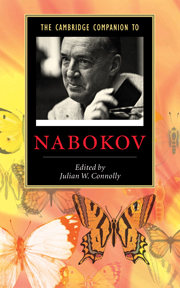Book contents
- Frontmatter
- Introduction
- Part I Contexts
- Part II Works
- 6 Nabokov as poet
- 7 Nabokov’s short fiction
- 8 The major Russian novels
- 9 From Sirin to Nabokov
- 10 Nabokov’s biographical impulse
- 11 The Lolita phenomenon from Paris to Tehran
- 12 Nabokov’s late fiction
- Part III Related worlds
- Guide to further reading
- Index
- Series List
10 - Nabokov’s biographical impulse
art of writing lives
from Part II - Works
Published online by Cambridge University Press: 28 May 2006
- Frontmatter
- Introduction
- Part I Contexts
- Part II Works
- 6 Nabokov as poet
- 7 Nabokov’s short fiction
- 8 The major Russian novels
- 9 From Sirin to Nabokov
- 10 Nabokov’s biographical impulse
- 11 The Lolita phenomenon from Paris to Tehran
- 12 Nabokov’s late fiction
- Part III Related worlds
- Guide to further reading
- Index
- Series List
Summary
“[T]he motifs of Chernyshevski's life are now obedient to me,” Fyodor Godunov-Cherdyntsev tells his imagined reader in Nabokov's Gift. “I have tamed its themes, they have become accustomed to my pen; with a smile I let them go: in the course of development they merely describe a circle, like a boomerang or a falcon, in order to end by returning to my hand; and even if any should fly far away, beyond the horizon of my page, I am not perturbed; it will fly back . . .” (Gift, 236-37 [ch. 4]).
The Gift, written in 1935–1937, is a perfect, concrete place to ground our general discussion of major trends in Nabokov’s art of biographical and autobiographical presentation, for the novel richly contains them all. In addition to the “real” biography of N. G. Chernyshevski, a nineteenth-century Russian writer, publicist, and political activist (chapter 4), it features an unfinished biographical sketch of Fyodor’s father (chapter 2), which contains themes from the life of Nabokov’s own father; and it also presents a “fictional” biographical exposé of Berlin émigré and Chernyshevski namesake, Yasha Chernyshevski (chapter 1). Furthermore, the novel as a whole is one of the classic examples of an autobiographical Bildungsroman, akin to Joyce’s A Portrait of the Artist as a Young Man.
- Type
- Chapter
- Information
- The Cambridge Companion to Nabokov , pp. 170 - 184Publisher: Cambridge University PressPrint publication year: 2005
- 1
- Cited by

